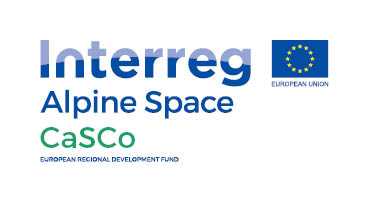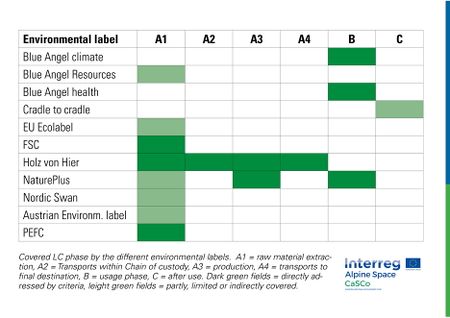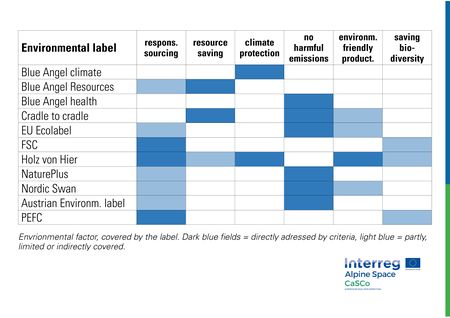Comparisons environmental labels
considered life cycle stages and environamental aspects
The following environmental labels were included in the evaluations (alphabetically): Blue Angel (blauerengel.de), Cradle to Cradle (epea.com), European Eco-label (eu-ecolabel.de), FSC (fsc.de), HOLZ VON HIER (holz-von-hier.de), NaturePlus (natureplus.org), Nordic Swan (nordic-ecolabel.org), Austrian Eco-label (umweltzeichen.at) and PEFC (pefc.de).
The life cycle phase covered by the respective eco-label: A1 = extraction of raw materials, A2 = transport along the chain of custody, A3 = production, A4 = transport to the construction site, B = use phase, C = subsequent use.
Dark green areas = directly covered by criteria, light green areas = partially, restricted or indirectly covered. Dark blue = directly covered by criteria, light blue = indirect effects or restricted effects.
Responsible sourcing
Sustainable and responsible raw material extraction should be a general requirement for all raw materials and materials used. However, corresponding environmental labels and certificates have so far developed and established themselves almost exclusively in the wood sector. Here, the two global forest certification systems FSC and PEFC are traditionally known. Other labels require corresponding proof for wood from sustainable forestry, albeit in different forms.
Sustainable forestry
The globally operating forest certification systems FSC and PEFC have two different types of standards: (1) the Forest Management Standard (FM) for the type of forest management and (2) the COC standard, which is intended to ensure that no more wood products with the forest label are marketed along the processing chain than the number of raw materials required for this purpose. Both systems offer different models within the COC Standard, on the one hand the model of physical separation of certified and non-certified material, on the other hand quantity weighted models such as the percentage method and the credit model. Only in case of physical segregation would a physical identity of wood in a certified product with wood from certified forests be guaranteed. In practice, such a guarantee is not (very rarely) given because already in the first stages of processing, volume-weighted models are predominantly used.
| Label | Wood from sustainable forestry |
|---|---|
| Blauer Engel | 50% of the wood should come from sustainable forest management, the rest from legal sources according to the EUTR. |
| EPEA | Cradle-To-Cradle wood "from sustainable management" is required, whereby the type of proof and the percentage could not be determined from the label website. |
| EU ecolabel | (1) 70% share from sustainable sources for solid wood, (2) 40% for wood-based materials |
| FSC | the proportion varies from any proportion in FSC mix and FSC controlled wood up to 100% in FSC pure |
| HOLZ VON HIER | 100% Quantity of wood used in certified products must come from sustainable forestry, proven by an FM certificate from FSC, PEFC or equivalent. |
| NaturePlus | Proof of the origin of the wood from sustainable forestry is required, the proportion is (unclear but) probably 100%. |
| Nordic Swan | Proportions vary between >10%, >50% up to >70% depending on the product standard. |
| Ö-UZ | 70% minimum share for wood energy, 50% for solid wood, floors, furniture, exterior wood. No information for insulation materials. |
| PEFC | the minimum percentage of the total quantity processed is specified in the PEFC standard, the material must come from PEFC certified forests |
Resource saving
The responsible use of resources is more important today than ever. We Europeans consume about twice as many resources as we have. The only resources that are renewable on a large scale in Europe are wood and straw.
| Label | aspect of resource conservation |
|---|---|
| Blauer Engel | Of the 113 Blue Angel standards, 20 relate to the protection of resources, none in the area of construction and renovation and only 5 of 20 with paper products. Here the claim "Conserve resources" means the use of waste paper or recycled paper. Other resource aspects are not the focus of the "Blue Angel - Saving Resources". |
| EPEA | The environmental label cradle to cradle (C2C) does not contain any specific criteria for the conservation of resources. However, the basic concept "elimination of waste (in theory) corresponds to the conservation of resources. The criterion of material recycling is to be seen in analogy to the principle of recycled paper at the Blue Angel. (Note: in practice, product cycles are generally far removed from the natural model of closed cycles). |
| EU ecolabel | The EU Ecolabel has not developed any direct criteria for resource protection and is reduced to the sustainable extraction of wood and low energy consumption in production. The energy consumption in production is usually calculated. |
| FSC | The central message of the FSC eco-label is the sustainable management of the forest to obtain the raw material wood. In addition to various social and environmental requirements, the focus of FSC is therefore on the conservation of wood as a resource by means of management that is intended to ensure its use for future generations. |
| HOLZ VON HIER | HOLZ VON HIER is characterized by renewable raw materials from sustainably managed forests. The transports in the processing chain and to the customer are above average short and therefore also save resources. |
| NaturePlus | NaturePlus demands a "preferably high" proportion of renewable raw materials in the product and a minimisation of energy consumption. |
| Nordic Swan | The Nordic Swan addresses resource conservation rather indirectly. In general, at least 50% of the materials should be renewable and, in the case of wood, at least 30% should come from sustainably managed forests. Energy consumption in production must not exceed a certain value and high-calorific production waste should be returned to the energy cycle. |
| Ö-UZ | The Austrian Ecolabel has not defined any specific criteria for the conservation of resources. The award criteria for furniture are defined as regulations for raw materials, which primarily concern the avoidance of ingredients that are hazardous to health, as well as environmentally friendly production, durability and waste reduction, and packaging aspects. |
| PEFC | The central message of the PEFC eco-label is the sustainable management of the forest for the extraction of the raw material wood. In addition to various requirements, the focus is on the conservation of wood as a resource by means of a management system that is intended to safeguard this use for future generations. |
climate protection
There are different starting points for climate protection measures in the life cycle phases, either in the upstream production chains (LC Phase A1,A2, A3, A4) or in the use phase (B) of the product.
Climate-friendly short distances and the associated environmental impact of the entire processing chain "cradle-to-gate" (A2) as well as from the production site to the place of use or application "gate-to-customer" (A4) are covered by the eco-label WOOD FROM HERE. In today's international markets, emissions from such transport routes can easily reach many times the total emissions from the manufacture of the product, even for wood products. The ecolabel HOLZ VON HIER is unique in this respect, as it records and evaluates all flows of goods right through to the end use location. The Hvh environmental footprint records classic environmental parameters (e.g. GWP, AP, EP, etc.) for each product in real time. (B) Construction products are 'inert' from an energy point of view in the use phase, i.e. no product-related emissions are produced in this life cycle phase. (C/D) Climate-efficient disposal or re-use is also essentially a question of materials. PVC, for example, has considerably lower recycling rates than waste wood, for example. However, the emissions and energy expenditure associated with processing also play an important role here.
| Label | pre chains | usage phase |
|---|---|---|
| Blauer Engel | - | Climate protection effects in "red energy" through lower energy consumption of electrical appliances and lamps compared to the average |
| EPEA | - | Climate protection effects in "red energy" through lower energy consumption of electrical appliances and lamps compared to the average |
| EU ecolabel | - | Climate protection effects in "red energy" through lower energy consumption of electrical appliances and lamps compared to the average |
| FSC | - | - |
| HOLZ VON HIER | Climate protection effects due to short distances cradle-to-gate and gate-to-customer in the "grey energy" of the prekets | Note: Wood building materials are inert in the use phase (do not consume energy themselves) |
| NaturePlus | - | - |
| Nordic Swan | - | Climate protection effects in "red energy" through lower energy consumption of electrical appliances and lamps compared to the average |
| Ö-UZ | - | Climate protection effects in "red energy" through lower energy consumption of electrical appliances and lamps compared to the average |
| PEFC | - | - |
Biodiversity
The IUCN international Red List classifies species as endangered and includes, for example, considerably more tree species than the CITES Convention.
"By promoting the demand for a wide range of timber species from regional indigenous forestry, incentives are created for local farmers to preserve and promote the diversity of tree species in their forests, which in turn forms the basis for a high diversity of accompanying animal and plant species" (HVH).
In its transfer of information, HOLZ VON HIER shows that global transport has a significant impact on the risk of biodiversity loss. Depending on its origin, more species are endangered by transport than by the extraction of the raw material itself. By minimizing the transports, especially over long distances and from other countries or continents, HOLZ VON HIER contributes to the protection of biodiversity.
Table Biodiversity
| Label | Biodiversity |
|---|---|
| Blauer Engel | no criteria |
| EPEA | no criteria |
| EU ecolabel | no criteria |
| FSC | no direct criteria (Selection of tree species appropriate to the location). But indirectly protecting biodiversity through protection from overexploitation. |
| HOLZ VON HIER | No use of wood from internationally endangered tree species according to the IUCN International Red List. Indirect promotion of biodiversity in native forests. |
| NaturePlus | No use of wood from CITES species. |
| Nordic Swan | no criteria |
| Ö-UZ | no criteria |
| PEFC | no direct criteria (Selection of tree species appropriate to the location). But indirectly protecting biodiversity through protection from overexploitation. |
Period of validity of the standards
The validity period of standards also plays a role in assessing the environmental impact of eco-labels. Products or companies are usually certified for a certain period of time, i.e. the label can be awarded to all corresponding products manufactured within this period. The longer this period of time, the further the requirements set may lag behind current technical developments. This can be observed especially with labels for electrical appliances.
| Label | Number of standards or public procurement directives | Period of validity of the standard, standard revision | Validity of the certificate, audit frequency |
|---|---|---|---|
| Blauer Engel | 113 total thereof 3 timber products thereof 5 paper | 2 to 12 years | 1 time in the validity period Standard |
| EPEA | 1 | 2 | 1 time in the validity period Standard |
| EU ecolabel | comparable to Blue Angel | validity unlimited until change of standard | 1 time in validity period standard |
| FSC | FSC-FM country specific, FSC mix, FSC controlled wood, FSC 100%, FSC recycling | 5 years | |
| HOLZ VON HIER | 1 | 5 years | Real-time and individual product-related. |
| NaturePlus | ? | 3 years | 1 time in the standard validity period |
| Nordic Swan | ? | 3-5 years | 1 time in the standard validity period |
| Ö-UZ | ? | 4 years | 1 time in the standard validity period |
| PEFC | similar to FSC | 5 years | annual |
Product group relevance
Nicht jedes Label ist für alle Produktgruppen aus dem Bereich Bauen, Renovieren und Wohnen relevant. Die meisten Umweltzeichen haben hier einen Schwerpunkt. Wichtig ist dies vor allem dann zu beachten, wenn Umweltlabel grundsätzlich breit über unterschiedliche Produktgruppen aufgestellt sind, wie z.B. der Blauer Engel. Zudem gibt es teils Vergabekriterien für bestimmte Produktgruppen, ohne dass es bereits konkrete zertifizierte Produkte aus dem Bereich gibt. In der folgenden Tabelle wird ein Überblick über die betroffenen Produktgruppen gegeben sowie die Zahl der existierenden Produkte, sofern diese aus entsprechenden Webseiten ermittelbar waren.
| Label | Zahl der Produkte allgemein | darunter Produkte aus Holz oder Papier |
|---|---|---|
| Blauer Engel | >14000 | 67 Holzmöbel (v.a. Spanplatte),
8-9 holzbasierte Platten, 11 Paneele (aus Europa, Russland, Taiwan, Shanghai, Türkei, Afrika, Japan), 6 Zargenprodukte eines Herstellers (keine Türen und Fenster, 2 Pelletproduzenten, 80 Kopierpapiere, 509 Papierprodukte generell , 528 Recyclingpapier, 299 Pappe , 56 Zeitungspapier |
| EPEA | 490 | 14 Holzprodukte, 6 Papierprodukte |
| EU ecolabel | 774 | keine Holzprodukte, 63 Papierprodukte |
| FSC | unbekannt | verschiedene Holz- und Papierprodukte |
| HOLZ VON HIER | mehrere hundert | verschiedene Holzprodukte, Papier, Objekte |
| NaturePlus | 641 | 94 NaWaRo Dämmstoffe, 14 Fußböden |
| Nordic Swan | 2.587 Gebäude | 130 Kleingebäude aus Holz |
| Ö-UZ | 438 | ca. 43 Holzprodukte, 15 Papierprodukte |
| PEFC | unbekannt | verschiedene Holz- und Papierprodukte |


